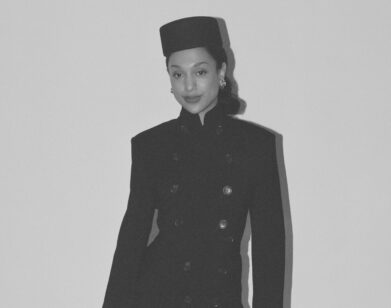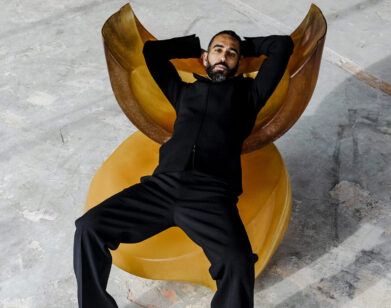Hanna Liden
Thirty-four-year-old artist Hanna Liden first made her mark on the New York art scene in the mid-2000s with a series of bleak color landscape photographs populated by menacing masked youths. In a way, these works are nature studies—rugged quarries, placid lakes, overgrown fields, and leafless forests, which give a primal, prehistoric aura. But it was the rough, gangly figures looming under Liden’s overcast skies that made her work feel so urban, delinquent, and hostile.
Liden’s photographs, many of which were shot in the countryside of her native Sweden, were in some ways just as indicative of the fast-paced downtown subculture as the more streetwise art productions of her friends Nate Lowman, Agathe Snow, and the late Dash Snow. But in the last two years, Liden has refined her vision, producing a new set of images that look simultaneously like pagan rituals and contemporary psychograms. She’s now taken her photography inside, making her studio the primary setting, and using elaborate or found props in her self-portraits and still lifes. Earlier this year, she presented a series of shots of blackened candles, their silhouettes taking the haunting form of a demolished city skyline.
Liden’s subject matter tends toward the dark side, but she has plenty of people in New York who love her. This month, she and Nate Lowman are collaborating on an exhibit together at Salon 94 gallery on the Upper East Side, which will not only showcase their varying histories of landscape photography and painting, but will also include more intimate notes, drawings, and paraphernalia of their long friendship. Here, the two talk at Liden’s Chinatown studio about art, plaster masks, and living above meth labs.
NATE LOWMAN: We both came to New York in the late 1990s. What was your life like before you moved here?
HANNA LIDEN: I grew up in the suburbs in Sweden, and moved into my own apartment in Stockholm at 17. I worked as a photo assistant for a Swedish celebrity photographer, and I also worked in television. But I felt like Stockholm was too provincial, so I moved to London, where I was pretty much a slacker for a year. I felt paralyzed by the cynical London mentality. During the day, I just watched movies I rented from the video store on Camden High Street, and at night I went to clubs and did Ecstasy. No future in that. So I moved to New York in 1998. I remember being culturally shocked by American optimism. Now I don’t notice it anymore.
LOWMAN: Can you list all of the neighborhoods you’ve lived in in New York?
LIDEN: Lower East Side, Chelsea, Upper West Side, Harlem, Williamsburg, Bushwick, SoHo, Noho . . . Now I live in Chelsea again.
LOWMAN: What’s the craziest thing that’s happened to you in one of those places?
LIDEN: The last time I lived in Chelsea, there was a meth lab in the apartment below mine. There were always fumes in the stairway. I got high from walking up the stairs. Once, the building caught fire. I was home sleeping and was woken up by the sirens of 10 fire trucks outside my window. My instinct—or mood—told me to pull the sheets over my head and just wait it out. I didn’t feel like getting out of bed at all, but I was forced to when a fireman started knocking really hard on the door of my tiny studio. As I opened the door, they were already getting ready to kick it down. Five firefighters dressed in smoke gear entered my apartment. They were using some electronic device to search for heat inside the walls. They looked like they were going to knock the walls out. I just left and went to have a drink in the bar downstairs. A week later the lab was back in business.
LOWMAN: What are you working on art-wise now?
LIDEN: I’m working on the show that I’m doing with you in November. That’s mostly about landscapes.
LOWMAN: The show is a pairing of my landscape paintings, which are largely of tombstones, with landscape photographs that you’ve taken in different parts of the world. But you also have a solo show before that, in Zurich.
LIDEN: Yeah, that one is almost like a photo show about painting. I realized that today. I’m building all these sets in my studio—which are still lifes—and a lot of them reference different paintings. I really wasn’t even doing that consciously.
LOWMAN: I’ve visited your studio on and off for years. And even when you were shooting landscapes, you were building tons of elaborate props and masks—combining handmade items with things you’d just come across and bought. Is this studio still-life photography similar to the landscapes for you? Is it basically just bringing that practice indoors?
LIDEN: The still-life series came about when I was working on my show at Rivington Arms in 2006. I decided to shoot some of the props that were intended to be incorporated in the narrative landscapes. That’s how it began. Recently I did a whole still-life series with black candles. To me, those candle photos are really cityscapes, so that is really moving away from nature and bringing the work into the city.
LOWMAN: Yeah, they have that feeling of a skyline to them.
LIDEN: I’ve been feeling compelled to do all of my work from start to finish in the city. I don’t have the urge to leave here as much as I did before. So this is a change in my process. I used to make so many props in my studio and they’d travel back and forth to Europe in my suitcase for shoots. There were lots of masks made from molds of my own face, in plaster, resin, papier-mâché, etc . . .
LOWMAN: What I like about your sets is that you have intensively painted backdrops and candles that you’ve burned down for hours to the exact right length. But you also do things like you suddenly add a crumpled dollar bill shoved into the mouth of a taxidermied crow, or some weird rubber eyeball that came from a 99-cents store in Chinatown. There is something extremely sculptural about your photography. They never remain in the second dimension for me. They even seem more like portraits than still lifes. You often put yourself in your work, even if it’s just a hand holding a skull.
LIDEN: Yes, I do. Even when I was doing the landscapes, I inserted people who kind of worked as representatives of myself. But lately I’ve been doing self-portraits in my studio. And besides myself, I don’t really shoot people at the moment.
LOWMAN: There is also something quite cinematic about your still lifes. Did film influence you? What films and genres are you drawn to?
LIDEN: When I was 20, I watched Aguirre: The Wrath of God [1972] for several months. And I watched every other [Werner] Herzog film that I could get a hold of. I think he’s been a big spiritual inspiration. As a teenager, I loved David Lynch. I watched Eraserhead [1976] and The Elephant Man [1980] a lot. Another film that is somehow always with me is Tetsuo: The Iron Man [1989]. It’s incredibly creepy. I liked to watch the same film lots of times for a long period. I remember being very taken by A Nightmare on Elm Street [1984] as a child. It terrified me. The other big piece of film was Michael Jackson’s “Thriller” [1983]. I loved the scary, campy stuff. I never liked films about dogs and girls and boys and little mermaids and things like that. And, of course, growing up in Sweden, [Ingmar] Bergman was always on the television. I remember Fanny and Alexander [1982] always being on at Christmastime.
LOWMAN: Herzog and MJ should have made a movie together! Do you think that your shift toward working in the studio and away from cinematic tendencies has to do with New York City?
LIDEN: I don’t think I would have ever thought of making those cinematic landscapes in the first place unless I had been in New York City—or at least in America. They were really a crossover between Nordic landscapes, paganism, and American horror cinema. But I’m not really new to the city anymore. I’ve been here for 35 percent of my life.
LOWMAN: Now that most of us have made it through our twenties, who inspires you in your early thirties?
LIDEN: Mostly my close friends—you, Dan Colen, Adam McEwen, Agathe Snow, and my sister Klara Liden. You’re all inspiring in a day-to-day kind of way—how to make the work, how to live, how to make it work.
Nate Lowman is a New York–based artist who has recently shown work at the Whitney Museum of American Art and the Guggenheim Museum.







